
29 May - 6 June,
2009
Organisers:
- Paul Bons & Jens Rößiger Mineralogy and Geodynamics, Inst. for Geosciences, Tübingen University
Please check literature to read before the field trip
Please remember to register as a driver
Departure: 07:30 from Europcar, Tübingen
Table of contents:
View on the
field area: Cap de Creus, where the Pyrenees reach the Mediterranean Sea
|
 |
Introduction

Cap de Creus is the easternmost point of the Pyrenees, just south of the Spain-France border. It is part of the central "Axial Zone" of the Pyrnees (a), which contains Precambrian - Paleozoic rocks, which were deformed and metamorphosed during the Palaeozoic Variscan Orogeny. The main field area (retancle c in fig. b) is located about 5 km away from the town Cadaqués. Precambrian-Ordovician meta-sediments are found there, with a high metamorphic grade (amphibolite facies, up to anatexis). Variscan magmatic rocks that occur are two large granite bodies outside of the mapping area and many small pegmatite bodies in the mapping area. The area is a Natural Park, because of its natural beauty, geological heritage and precious flora and fauna.
The rocks were deformed several times during amphibolite facies metamorphism. Later, shear zones formed during retrograde greenschist facies conditions. The aim of the field exercise is to map and unravel the complicated tectonic - metamorphic - magmatic history of the area. This can be done with the many structures that are exposed, such as cleavages, folds, quartz veins, boudins, pegmatites, porphyroblasts, etc. Outcrops are excellent!
The beautiful Cap de Creus peninsula attracts many tourists, especially the Pentacost-weekend. We will therefore also do some exercises away from Cap de Creus:
- The Biure-antiform near Biure, about 30 km NW of Roses. Here we can "warm up" with a large-scale structure that formed during the Alpine Orogeny in Mesozoic rocks.
- Shear zones on a coastal platform near Roses. Here we will see the Roses Granodiorite, which is cut by many shear zones.
- An excursion
along the coast East of Rosas, to see spectacular mega quartz veins,
and low metamorphic grade rocks that were folded several times. The day
ends at a nice beach with bar.
The results of
the
exercises will be presented in short reports
and maps, which will be made during the field
trip.
Schedule
On Friday May 25th, we will drive from Tübingen to Garriguella, just across the Spanish border. It is a long drive, so be in time on Friday morning! We stay at the camp ground of Garriguella.
- 29 May, 07:30 AM - Departure from Europcar (near railway), Tübingen, travel to Garriguella (Spain)
- 06 June - Travel Cadaqués to Tübingen, arriving (late) in the evening
(if not, bad luck, take the train or whatever to get there)
Accommodation
- Camping
Vell
Empordà (Friday-Monday): 6-person bungalows, with showers and
kitchen
- Ctra. Vilajuiga s/m, 17780 Garriguella, Girona, Spain
- Tel: +34 - 972530200
- Fax: +34 - 972552343
- Carpe Diem Club Cadaqués (Monday-Saturday) 6/7-person bungalows, with showers and kitchen
- Tel: +34 - 972258131
- Fax: +34 -
972258914
What to bring
| Geological items |
|
| Apart from
usual clothes
and personal items: (please keep to a minimum to reduce luggage!) |
|
| Eating and
sleeping We stay in bungalows all the time. The bungalows have beds and blankets (but no sheets or towel). They are also fully equiped with kitchen, plates, cups, pots, etc. |
|
Picture gallery
More pirctures from the 1st TectTask field workshop to the same are can be found here
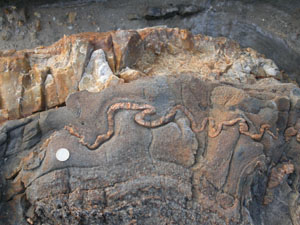 |
 |
| Refolded quarz veins in metapelites show the complex multiple deformation in the area | Andalusite porphyroblasts in metapelite indicate the high metamorphic grade |
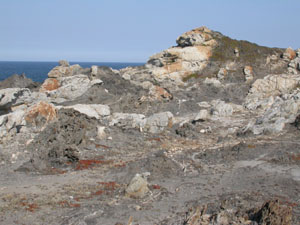 |
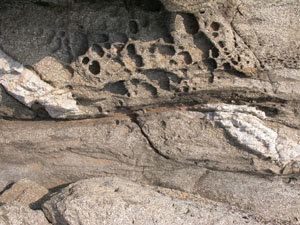 |
| Many pale pegmatites cut through the rocks | Retrograde shear zones cut through the Roses Granodiorite. Aplite dykes are offset by the sinistral shear zone shown here. |

Cadaqués is best known as the home town of Salvador Dalí, who ensured that Cadaques remained mostly untouched by big hotel developements
Some links:
Cadaqués:
- A virtual tour of cadaqués: http://www.virtourist.com/europe/cadaques/
- Information on Cadaqués and the Nature Park: http://www.publintur.es/guiacata/cbrava/cadaques/cadaques.htm
- And also in Catalan! http://pieraedicions.com/cadaques.html
- The web site of the Park: http://www.parcsdecatalunya.net/capdecreus.htm
- Pictures of rare birds (shearwaters) at Cap de Creus: http://www.terra.es/personal5/arbmor/arbsf019.htm
- Weather bureau of Catalunya: http://www.gencat.es/servmet/
- Garriguella Virtual: http://www.ddgi.es/garrigue/
Some literature (with links to download pdf-files)
- Bons, P.D., Druguet, E., Hamann, I., Carreras, J. Passchier, C.W. (2004) Apparent boudinage in dykes. Journal of Structural Geology 26, 625-636.
- Carreras, J. 2001. Zooming on Northern cap de Creus shear zones. Journal of Structural Geology 23, 1457-1486.
- Carreras, J.,
Druguet, E., Griera, A. (2005) Shear
zone-related folds. Journal
of Structural Geology 27, 1229-1251.
- Carreras, J.,
Druguet, E., Griera, A., Soldevila, J. (2004) Strain and deformation history in a
syntectonic pluton. The case of the Roses granodiorite (Cap de Creus,
Eastern Pyrenees). Geol. Soc. London Speci. Publ. 224, 307-319.
- Druguet, E., Passchier, C.W., Carreras, J., Victor, P., den Brok, S. 1997. Analysis of a complex high-strain zone at cap de Creus, Spain. Tectonophysics 280, 31-45.
- Druguet, E. 2001. Development of high thermal gradients by coeval transpression and magmatism during the Variscan orogeny: insights from the Cap de Creus (Eastern Pyrenees). Tectonophysics 332, 275-293.
- Druguet, E., Hutton, D.H.W. (1998) Syntectonic anatexis and magmatism in a mid-crustal transpression shear zone: an example from the Hercynian rocks of the eastern Pyrenees. Journal of Structural Geology 20, 905-916.
- Gomez-Rivas, E.,
Bons, P.D., Griera, A., Carreras, J., Druguet, E., Evans, L. (in
review) Strain and vorticity
analysis using small-scale faults and associated drag folds.
Journal of Structural Geology.
Download the aerial photograph scans of the mapping areas A to D
 Area A (3.1 Mb) |
 Area B (2.3 Mb) |
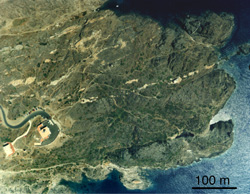 Area C (1.9 Mb) |
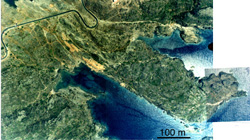 Area D (3.4 Mb) |